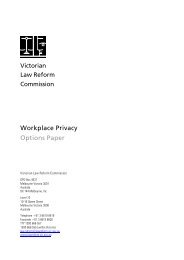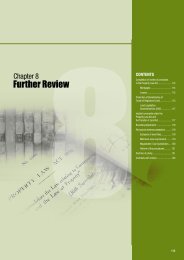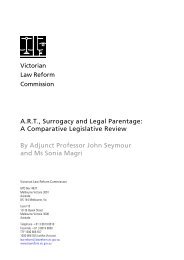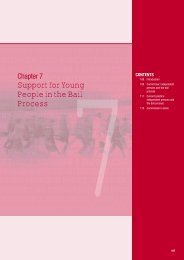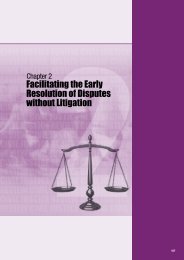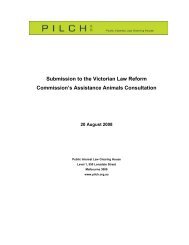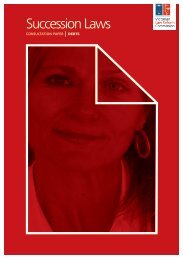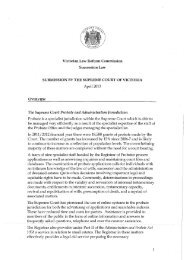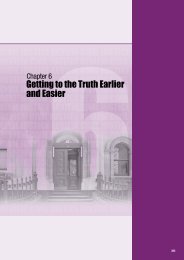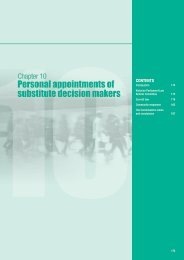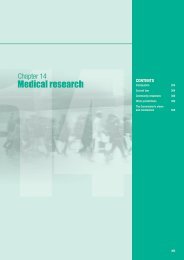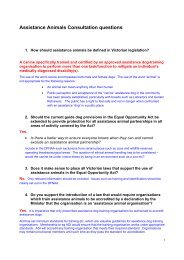12Facilitating Ongoing Civil Justice Review and Reform
12Facilitating Ongoing Civil Justice Review and Reform
12Facilitating Ongoing Civil Justice Review and Reform
Create successful ePaper yourself
Turn your PDF publications into a flip-book with our unique Google optimized e-Paper software.
Court Rules 1992. They are the culmination of a substantial amount of work by JRAC, the<br />
Judges of both Courts <strong>and</strong> of the former Parliamentary Counsel, Mr G Hackett-Jones QC,<br />
<strong>and</strong> other staff in his office. 40<br />
By contrast, NSW, Queensl<strong>and</strong> <strong>and</strong> the ACT each have a single rules committee to develop <strong>and</strong><br />
monitor rules for all courts within their jurisdiction. These committees have been established in the<br />
context of developing uniform or harmonised rules between the courts within those jurisdictions.<br />
New South Wales<br />
<strong>Civil</strong> procedure in all courts in NSW is now governed by the <strong>Civil</strong> Procedure Act 2005 (NSW) <strong>and</strong> the<br />
Uniform <strong>Civil</strong> Procedure Rules 2005 (NSW), which introduced common rules <strong>and</strong> procedures in civil<br />
proceedings in the Supreme, District <strong>and</strong> Local Courts. The uniform rules apply in all civil proceedings<br />
in the Supreme <strong>and</strong> District Courts; the Dust Diseases Tribunal; <strong>and</strong> the General Division <strong>and</strong> Small<br />
Claims Division of the Local Court.<br />
To the extent that each court retains the power to make local rules, they are not authorised to make<br />
local rules to amend or repeal a uniform rule in its application to that court. 41 The uniform rules prevail<br />
over any provision of any local rules unless the uniform rules expressly provide that the provision of the<br />
local rules is to prevail. 42<br />
The <strong>Civil</strong> Procedure Act 2005 empowers a senior judicial officer of the court to issue practice notes. 43<br />
The practice notes are statutory rules for the purposes of the Interpretation Act 1987 (NSW) <strong>and</strong> can<br />
be disallowed. 44<br />
The <strong>Civil</strong> Procedure Act 2005 provides for a Uniform Rules Committee comprising 10 members,<br />
including:<br />
(a) the Chief <strong>Justice</strong> of the Supreme Court or a judge of the Supreme Court nominated by the<br />
Chief <strong>Justice</strong><br />
(b) the President of the Court of Appeal or a judge of appeal nominated by the President<br />
(c) two judges of the Supreme Court appointed by the Chief <strong>Justice</strong><br />
(d) the Chief Judge of the District Court or a judge of the District Court nominated by the<br />
Chief Judge<br />
(e) a judge of the District Court appointed by the Chief Judge<br />
(f) the Chief Magistrate or a magistrate nominated by the Chief Magistrate<br />
(g) a magistrate appointed by the Chief Magistrate<br />
(h) a barrister appointed by the Bar Council<br />
(i) a solicitor appointed by the Law Society Council. 45<br />
In addition to the Uniform Rules Committee, a <strong>Civil</strong> Procedure Working Party exists to develop<br />
amendments to the rules <strong>and</strong> review civil forms. It has a cross-jurisdictional composition <strong>and</strong> in<br />
addition to judicial officers it includes representatives from the NSW Bar, Law Society <strong>and</strong> Attorney-<br />
General’s Department. The working party developed the uniform rules <strong>and</strong> the <strong>Civil</strong> Procedure Act in<br />
consultation with the judiciary, profession <strong>and</strong> special interest groups. 46 In producing the uniform rules,<br />
the working party simplified <strong>and</strong> consolidated the rules, but retained existing concepts <strong>and</strong> phrases in<br />
order to preserve the substance of the rules.<br />
Queensl<strong>and</strong><br />
The Supreme Court of Queensl<strong>and</strong> Act 1991 provides that the Governor in Council, with the consent<br />
of the rules committee, may make rules of court, to be known as the Uniform <strong>Civil</strong> Procedure Rules,<br />
in respect of the practice <strong>and</strong> procedure of the Supreme Court, District Court, <strong>and</strong> Magistrates’<br />
Courts, their registries or other specified matters. 47 The Chief <strong>Justice</strong> is empowered to establish a Rules<br />
Committee consisting of the following members:<br />
(a) the Chief <strong>Justice</strong>, or a Supreme Court judge nominated by the Chief <strong>Justice</strong><br />
(b) the President or a judge of appeal nominated by the President<br />
(c) two Supreme Court judges nominated by the Chief <strong>Justice</strong><br />
(d) the Chief Judge or a District Court judge nominated by the Chief Judge<br />
33 Peter Sallmann <strong>and</strong> Richard Wright,<br />
Going to Court: A Discussion Paper on<br />
<strong>Civil</strong> <strong>Justice</strong> in Victoria (2000), 205–12.<br />
34 Ibid 232.<br />
35 Ibid.<br />
36 Courts Consultative Council [Victoria],<br />
Courts Strategic Directions Project<br />
(2004) 19.<br />
37 See Supreme Court Act 1935 (WA) Pt<br />
X, Supreme Court <strong>Civil</strong> Procedure Act<br />
1932 (Tas) Pt XIV, Supreme Court Act<br />
1979 (NT) s 71, Judiciary Act 1903<br />
(Cth) ss 86, 89, High Court Act 1979<br />
(Cth) s 48, Federal Court of Australia<br />
Act 1976 (Cth) s 59.<br />
38 There is a Rule Committee consisting<br />
of the judges, the master <strong>and</strong> four<br />
practitioners appointed by the<br />
Governor: s 202(1). The appointed<br />
members of the committee shall hold<br />
office for a period of 5 years: s 202(2).<br />
The Rule Committee shall meet once<br />
at least in each year, <strong>and</strong> as often<br />
as the Chief <strong>Justice</strong> may direct: s<br />
202(3): Supreme Court <strong>Civil</strong> Procedure<br />
Act 1932 (Tas). See also s 15AE<br />
Magistrates’ Court Act 1987 (Tas).<br />
39 The Family Law Act 1975 (Cth) s<br />
124 establishes a Rules Advisory<br />
Committee, consisting of such judges<br />
of the Family Court, such judges<br />
of family courts of states <strong>and</strong> such<br />
other persons as are appointed on<br />
nomination by the Attorney-General in<br />
consultation with the Chief Judge.<br />
40 Supreme Court of South Australia,<br />
Report of the Judges of the Supreme<br />
Court of South Australia to the<br />
Attorney-General Pursuant to Section<br />
16 of the Supreme Court Act 1935 for<br />
the Year Ended 31 December 2006<br />
(2006).<br />
41 <strong>Civil</strong> Procedure Act 2005 (NSW) s 10.<br />
42 <strong>Civil</strong> Procedure Act 2005 (NSW) s 11.<br />
43 <strong>Civil</strong> Procedure Act2005 (NSW) s 15.<br />
44 <strong>Civil</strong> Procedure Act2005 (NSW) s<br />
15(2).<br />
45 <strong>Civil</strong> Procedure Act 2005 (NSW) s 8.<br />
46 See Jenny Atkinson <strong>and</strong> Stephen<br />
Olischlager, An Introduction to <strong>Civil</strong><br />
Procedure Act 2005, Uniform <strong>Civil</strong><br />
Procedure Rules 2005 (2005); Laurie<br />
Glanfield, ‘Consistency in Court<br />
Rules—The NSW Partnership’ (Paper<br />
presented at the Australian Institute<br />
for Judicial Administration Annual<br />
Conference, Sydney, 17–19 September<br />
2004); <strong>Justice</strong> John Hamilton, ‘The<br />
NSW <strong>Civil</strong> Procedure Bill 2004 <strong>and</strong><br />
the Uniform <strong>Civil</strong> Procedure Rules:<br />
An Introduction’ (Paper presented<br />
at the Australian Institute for Judicial<br />
Administration Annual Conference,<br />
Sydney, 17–19 September 2004).<br />
47 Supreme Court of Queensl<strong>and</strong> Act<br />
1991 s 118.<br />
701



